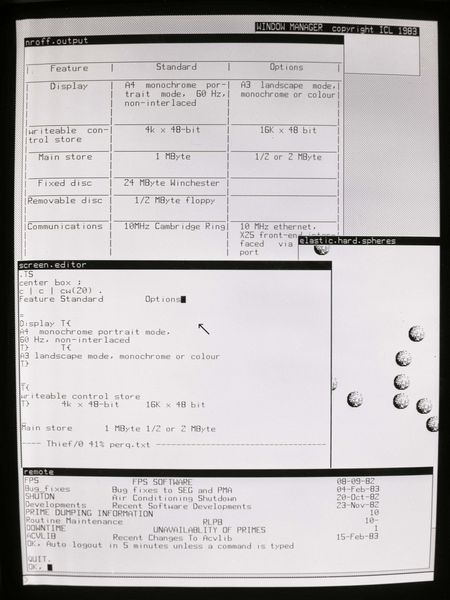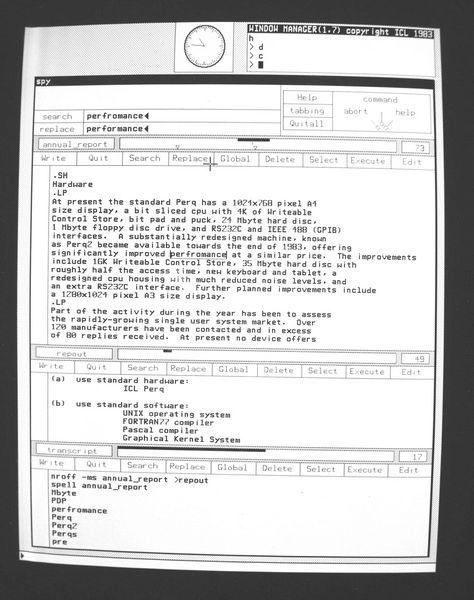

The major activities in 1983 were the introduction of PNX (Microcode UNIX) to existing POS users, and to define the long-term operating system strategy for the PERQ. PNX was still seen as a stop-gap product and the need for a fully distributed operating system was recognised within both ICL and SERC.
Apart from the Operating System itself, PNX also needed to deliver both FORTRAN and PASCAL compilers which, due to the change in direction, were well behind schedule.
There were three major phases to PNX development in 1983:
A major problem early in the year was the system targeted for by ICL. There was a need for ICL to support PNX on 4K WCS systems. Unfortunately it was impossible to provide good GKS performance without the 16K WCS upgrade. Consequently, ICL wanted to do all further PNX developments on the assumption that 16K WCS was available.
The major SERC work towards the early PNX releases was the continued porting of utilities and the FORTRAN compiler. The first tended to be routine work already done once for Accent UNIX. However, a few major utilities such as NROFF required a considerable amount of reworking and this was done by SERC staff.
Liz Fielding had been responsible for a significant amount of the FORTRAN developments on the Accent UNIX system and she was seconded to ICL to help do the PNX FORTRAN port. Again there were Not Invented Here problems with ICL's compiler experts taking a month to accept SERC's offer of assistance.
There was some slippage on the FORTRAN compiler due to changes being needed in the C system (again indicating the lack of portability in UNIX at that time). Even so, about 230 of a suite of 290 programs were running correctly in March, with the remaining failing on 13 faults, only 3 of which required a serious amount of work. Liz Fielding's expertise was a considerable help to ICL in this port.
Field releases of PNX with FORTRAN became available around March 1983. This was an acceptable UNIX system for the first time. Although compilation was slow, there was a window manager and decent screen editor provided by RAL. It was a system where real work could be done and, given the lack of PASCAL, was a reasonable development system for users.


ICL decided to contract for a higher performance and faster FORTRAN compiler around this time. RAL was part of the team that assessed a number of options before a contract was placed with ERCC to develop an optimised FORTRAN compiler for the PERQ.
The major release was in field test before the end of 1983. Major enhancements were:
This release marked the completion of the Common Base Software Development in the initial set of software. Enhancements to the performance and functionality would, of course, continue.
The complete change in direction to support PNX rather than Accent UNIX caused problems with the early release of PNX. However, PNX was available early in 1983 and performance steadily improved throughout 1983.
By the end of 1983, PNX still had problems in providing good performance for large systems requiring good virtual memory facilities. It also had problems in the AI area where the separation of code and data forced on programs by PNX was unacceptable where data often changed to program dynamically in mid execution.
SERC's activities over the year moved from basic systems development to more applications oriented areas and user support. As a result, the ability of SERC to provide significant manpower to the development activities decreased throughout the year.